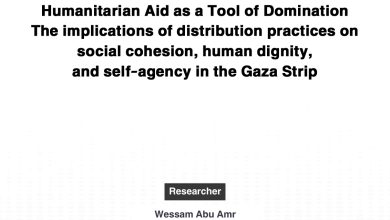Gaza on the verge of a humanitarian catastrophe: Gaza humanitarian crisis exceeds numbers and percentage

Omar Shaban – Gaza
The situation in the Gaza Strip is in need of a new evaluation, which the former economic and development pieces of the literature failed to address. The depth of the tragedy that Gazans bear cannot be explained by the abstract economic indexes and percentages such as unemployment and poverty rates. The accumulated consequences of the crisis, due to the blockade and the internal divide between Ramallah and Gaza paired with social marginalization, have negatively affected the social fabric and the collective conscience of the Gazans. The humanitarian crisis resulted in unhealthy behaviors and social relationships. The crisis has reached all sectors of society, even those in the working force. The percentages of direct and indirect dependency have increased for these sectors, too.
Living continuously under this pressure has rendered the population of Gaza exhausted. For instance, an undergraduate student does not have the money to go to university, a patient cannot afford to buy medicine, young people are unable to get married, more people are getting homeless, a professor works as taxi driver in the afternoon, a taxi driver works for 12 continuous hours every single day to make a living , a doctor comes to the hospital on foot, a policeman maintains the public safety day and night but gains nothing in return, a teacher cannot return to his home with basic needs, parents feel humiliated due to their failure to satisfy sons’ expectations, thousands of traders are bankrupt, unprecedented economic recession, and shattered purchasing power. Not to mention the terrific increases in extremism, depression, and the desire to commit suicide. Generally, the entire community is totally depressed.




